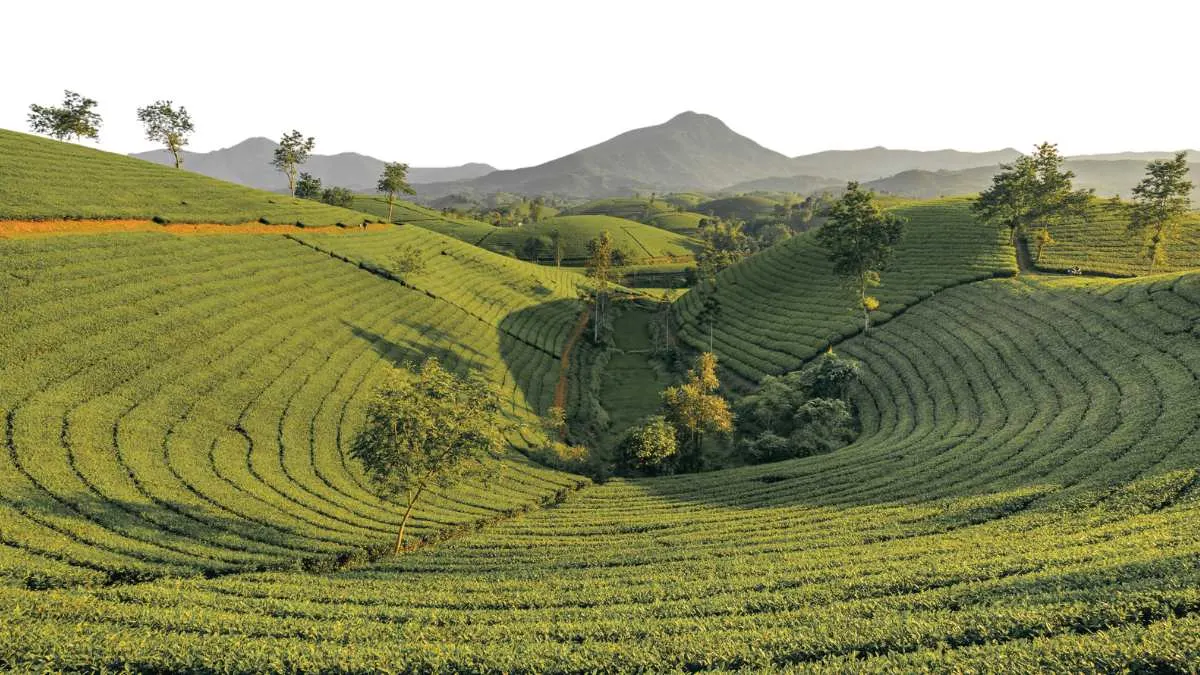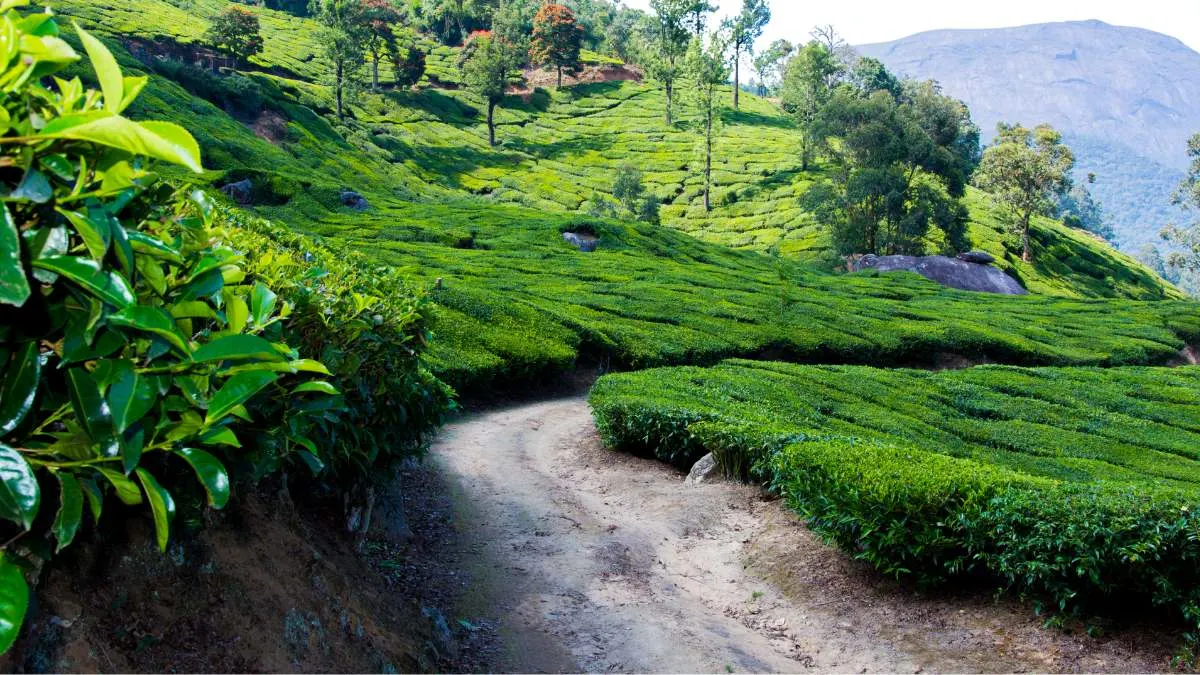Nestled in the rolling hills of Kerala, Munnar is a picturesque hill station known for its sprawling Tea Plantation In Munnar and scenic landscapes.
The town, surrounded by lush greenery and mist-covered mountains, is home to some of the best tea estates in India.
A visit to Munnar offers not just breathtaking views but also a chance to explore its rich tea-growing history, learn about the intricacies of tea cultivation, and experience the timeless tradition of tea-making.

The History of Tea Plantations in Munnar:
The history of tea plantations in Munnar dates back to the late 19th century when the British colonialists first introduced tea cultivation in the region. In 1880, the first tea seeds were brought to Munnar, and soon after, the region began to establish itself as a significant player in India’s tea industry. The climate in Munnar, with its cool temperatures and high rainfall, proved to be ideal for growing tea.
The lush, hilly terrain made it possible to cultivate tea at higher altitudes, enhancing the quality of the leaves.
Over time, Munnar’s tea plantations expanded, and today, the region produces some of the finest teas in India. Munnar is now home to a number of world-renowned tea estates, such as the Tata Tea Estate and KDHP (Kannan Devan Hills Plantations), which contribute to both the local economy and the global tea market.
The Unique Characteristics of Tea from Munnar:
The tea cultivated in Munnar is known for its distinctive flavors and high quality. This is primarily due to the region’s unique climate and soil conditions, which allow the tea leaves to develop rich, aromatic flavors. Munnar’s elevation—ranging from 1,500 to 2,600 meters above sea level—combined with its cool temperatures, provides an ideal growing environment for teas that are rich in flavor and aroma.
The most popular types of tea grown in Munnar include:
-
Black Tea: Known for its strong flavor, black tea from Munnar is robust and full-bodied, with a characteristic malty taste. It is the most widely grown tea in the region.
-
Green Tea: Munnar is also famous for its green tea, which is less oxidized than black tea, making it lighter and more refreshing. The region’s green tea has a mild, grassy flavor that tea lovers appreciate.
-
White Tea: A more delicate and rare variety, white tea is made from the youngest leaves of the tea plant and has a subtle, sweet flavor with a light, smooth texture.
-
Oolong Tea: This semi-oxidized tea is also grown in Munnar, offering a unique blend of floral and fruity flavors.
The tea from Munnar is prized not only for its taste but also for its health benefits. Munnar teas are rich in antioxidants, which are believed to help with digestion, boost immunity, and promote overall well-being.
Exploring the Tea Plantations in Munnar”
One of the best ways to experience the beauty and culture of Munnar is by visiting its tea plantations. These sprawling estates cover vast areas of land and are a sight to behold, with rows upon rows of neatly cultivated tea plants stretching across the hills. Most plantations in Munnar offer guided tours that take visitors through the tea gardens and provide insights into the entire process, from cultivation to processing.
A typical tour of a tea plantation in Munnar involves a walk through the lush plantations, where visitors can learn about how the tea plants are grown and harvested. During the tour, visitors are often shown how tea leaves are picked by hand by skilled workers known as “pluckers.” After the leaves are harvested, they are taken to the processing factory, where they are carefully sorted, dried, and packaged to preserve their flavors.
Many tea estates also offer a chance to taste different varieties of teas. Visitors can enjoy a freshly brewed cup of Munnar’s finest tea while overlooking the stunning views of the plantations. Some estates even have tea-tasting sessions, where guests can learn about the subtleties of tea flavor, aroma, and brewing techniques.
The Best Time to Visit Tea Plantations in Munnar:
The best time to visit Munnar’s tea plantations is between October and March, when the weather is cool and pleasant. During this time, you can enjoy the lush greenery and the vibrant landscape that Munnar is famous for. If you prefer to avoid the crowds, visiting during the weekdays or in the early mornings is recommended.
The monsoon season (June to September) also has its charm, as the tea estates come alive with a fresh coat of rain-washed greenery. However, this period can be a bit challenging due to heavy rainfall, which can make the terrain slippery and difficult to navigate.
Read Next: Boston Tea Party | Causes, Events, and Lasting Impact
How to Reach the Tea Plantations in Munnar:
Munnar is well-connected by road, making it easily accessible from major cities in Kerala and Tamil Nadu. The nearest major city is Kochi (approximately 130 kilometers away), and from there, you can take a bus or hire a taxi to Munnar. There are also frequent buses from nearby cities like Alappuzha, Thekkady, and Madurai.
The nearest railway station to Munnar is in Aluva, which is about 110 kilometers away. From there, you can take a taxi or a bus to reach Munnar.
Final Tips:
-
Wear Comfortable Footwear: Tea plantations can involve a lot of walking on uneven terrain, so make sure to wear sturdy shoes that will keep you comfortable during your visit.
-
Book in Advance: While many plantations accept walk-in visitors, it’s always a good idea to book your tour in advance, especially during the peak tourist season (October to March).
-
Stay at a Plantation Resort: For a truly immersive experience, consider staying at a tea estate resort. These resorts are often located amidst the plantations, offering stunning views and a peaceful, serene atmosphere.
-
Bring Your Camera: Munnar’s tea plantations are a photographer’s paradise, so don’t forget your camera to capture the beauty of the lush, green landscape.
-
Taste the Local Teas: Don’t leave without sampling a cup of fresh tea from the plantations. Many estates offer tea-tasting sessions, where you can try different varieties and learn about the nuances of flavor.
FAQs:
-
What types of tea are grown in Munnar?
Munnar is known for its wide variety of teas, including black tea, green tea, white tea, and oolong tea. Each variety has its own unique flavor profile, making Munnar a haven for tea lovers. -
How do I reach Munnar’s tea plantations?
Munnar is easily accessible by road from major cities like Kochi and Alappuzha. You can also take a train to Aluva and then hire a taxi or bus to reach Munnar. -
Can I visit the tea estates in Munnar?
Yes, most tea estates in Munnar offer guided tours where visitors can explore the plantations, learn about tea processing, and even enjoy a cup of freshly brewed tea. -
When is the best time to visit Munnar?
The best time to visit Munnar’s tea plantations is between October and March, when the weather is cool and pleasant. -
What is the health benefit of Munnar tea?
Munnar’s teas are rich in antioxidants and are known to promote good digestion, boost immunity, and enhance overall health.
Disclaimer:
This article is based on firsthand experiences and reliable sources. While every effort has been made to ensure the information is accurate, details may change over time. We encourage readers to check with local authorities and tea estates before planning their visit to Munnar’s tea plantations.
Munnar’s tea plantations are not just about the beautiful landscapes; they represent the soul of the region’s history, culture, and economy. Whether you’re a tea enthusiast or simply looking to experience the serene beauty of Kerala’s hill stations, the tea estates in Munnar offer an unforgettable experience that combines nature, tradition, and flavor.

